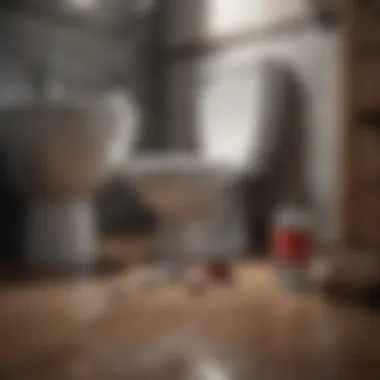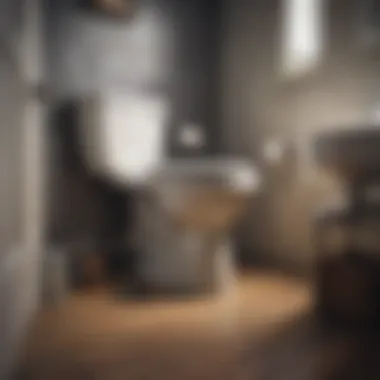Effective Solutions for a Clogged Toilet


Intro
Clogged toilets are a common frustration for many homeowners. They can arise without warning, causing inconvenience and potential mess. Understanding the causes of clogs and knowing how to address them is crucial for maintaining a functional bathroom. Many people hesitate to engage with plumbing problems, often because they lack the know-how. Fortunately, there are numerous effective solutions available.
This guide serves as a valuable resource for those who wish to tackle toilet obstructions. It covers the primary causes of toilet clogs, the tools necessary for resolution, and the step-by-step processes required for both self-service and when to call a professional. Additionally, preventative strategies are discussed, helping to reduce the frequency and severity of future blockages.
Common Causes of Clogs
Clogs can result from several factors. Below are some of the most prevalent:
- Excessive toilet paper: Many individuals underestimate how much toilet paper they flush. It can quickly add up and create a blockage.
- Foreign objects: Toys, feminine hygiene products, and other non-flushable items can result in significant clogs.
- Mineral buildup: Hard water can lead to mineral deposits in toilet pipes, which gradually narrow the flow.
- Tree roots: In older homes, tree roots may invade sewer lines, causing serious clogs.
Understanding these causes can empower homeowners to make informed decisions about preventing clogs.
Tools for Dealing with Clogs
A few simple tools can assist in effectively dealing with a clogged toilet:
- Plunger: The most basic tool, yet often the most effective for minor clogs.
- Toilet auger: A specialized tool designed to break up clogs deeper in the pipe.
- Wet/dry vacuum: Useful for removing water from a toilet if necessary.
These tools are essential for any homeowner, and having them on hand can save time and effort when faced with a blockage.
DIY Repair Techniques
When encountering a clogged toilet, there are effective DIY methods to consider:
- Using a plunger: Ensure a good seal around the toilet drain and plunge vigorously for about 15-20 seconds.
- Employing a toilet auger: Insert the auger into the toilet drain and twist the handle, pushing through any obstruction.
- Wet/dry vacuum use: Remove the water and vacuum out the clog, if accessible.
Each method works best for different types of clogs. Knowing which approach to use can significantly impact the success of the attempt.
When to Call a Professional
Some situations warrant professional intervention. Consider contacting a plumber if:
- Multiple toilets or drains are clogged simultaneously.
- The clog persists after multiple DIY attempts.
- There are signs of sewage backing up.
These indicators suggest a more significant issue, sometimes related to the plumbing system itself rather than just the toilet.
Preventative Measures
To help avoid future clogs, consider taking these precautions:
- Dispose of non-flushable items properly.
- Limit the amount of toilet paper used in a single flush.
- Regular maintenance: Periodically clean the toilet and check for potential issues.
By adopting preventative measures, homeowners can minimize the frequency of clogs.
End
Understanding how to efficiently address a clogged toilet is a vital component of home maintenance. Being equipped with the right tools and knowledge can empower any homeowner to resolve issues confidently. By taking preventive actions, the likelihood of future problems can be greatly reduced. Mastering this aspect of home care enhances overall living comfort.
Understanding Toilet Clogs
Understanding toilet clogs is crucial for any homeowner. Toilets are essential in every household, and clogs can lead to significant inconvenience and potential damage. Recognizing how clogs occur helps prevent bigger plumbing issues later. This section highlights the common causes and symptoms of a clogged toilet. Identifying these factors early can save time and money.
Common Causes of Clogs
Several specific elements contribute to clogs in toilets. By examining these causes, one can grasp what leads to blockages and how to mitigate them.
Excessive Toilet Paper Usage


Excessive toilet paper usage is one of the main causes of clogs. People often underestimate how much toilet paper they use. Overloading the system can create blockages.
The key characteristic here is the volume of paper flushed at once. While toilet paper is designed to break down in water, using too much at once can overwhelm the plumbing.
One unique feature of excessive toilet paper is its ease of prevention. By educating users on proper usage, homeowners can effectively reduce clogs. Informing family or guests on the appropriate amount can greatly be beneficial in maintaining toilet function.
Foreign Objects
Foreign objects are another common cause of toilet clogs. Things like children's toys, sanitary products, or wipes that are not flushable can easily create blockages.
The key characteristic of foreign objects is that they vary widely in size and material. Unlike biodegradable substances, these items do not break down easily, leading to persistent clogging.
Foreign objects present a unique challenge. They often require more than just standard home remedies to remove. In some cases, the use of a plumbing auger might be necessary, which calls for additional expertise.
Flushing Non-Biodegradable Items
Flushing non-biodegradable items is increasingly prevalent in households. Many believe that if an item can fit down the toilet, it can be flushed without issues. Common non-biodegradable items include plastic wrappers, certain wipes, and even some food products.
The key characteristic of non-biodegradable items is their long-lasting presence in plumbing systems. Once flushed, they can remain lodged in pipes much longer than natural materials, causing severe clogs over time.
The unique feature of these items is their potential for widespread damage to plumbing. This can ultimately lead to costly repairs, making clients more aware of what they flush essential to prevent issues.
Signs of a Clogged Toilet
Recognizing the signs of a clogged toilet is vital to preventing further complications. Below are some typical symptoms that indicate a blockage may be occurring.
Slow Drainage
Slow drainage is often the first sign of a potential clog. Water may not leave the bowl as quickly as it should, signaling an obstruction in the pipes.
The key characteristic of slow drainage is its gradual nature. Most homeowners can notice this shift over time, allowing for early intervention.
Addressing slow drainage early is beneficial. Ignoring this sign can lead to more severe clogs, which require more effort and resources to resolve. Regularly observing the drainage speed can help maintain optimal function.
Unusual Noises
Unusual noises from the toilet can also indicate a clog. Sounds such as gurgling or bubbling when flushing are common indicators.
The key characteristic of these noises is their inconsistency. They may only occur during specific usage, making them easy to overlook.
However, identifying these sounds early is beneficial. Ignoring unusual noises may lead to worse issues, such as a complete blockage or overflow. Homeowners should not ignore any abnormal sounds from their toilets.
Overflowing Bowl
An overflowing bowl is one of the most alarming signs of a severe clog. If the water rises to an unsafe level, immediate action is needed.
The key characteristic of an overflowing toilet is urgency. If left unattended, flooding can occur, leading to water damage and costly repairs.
Understanding the unique risk of overflow is critical. It not only creates a mess but can also compromise the hygiene of a home. Swift action can prevent extensive damage, making awareness of this sign imperative.
Initial Assessment
Assessing your toilet's condition is a pivotal step when dealing with clogs. Proper initial assessment can save time, effort, and even cost. Knowing how to effectively identify the type and severity of the clog helps in choosing the right tools and methods. This step ensures that a simple issue doesn't escalate into a major problem, which could require expensive repairs or professional help.
Gathering Tools and Supplies
Equipping oneself with the right tools is critical for addressing any clog effectively. Here we discuss the essential tools needed for tackling toilet clogs.
Plunger


The plunger is a fundamental tool in any household. Its simple design makes it an efficient solution for most clogs. A key characteristic of a plunger is its suction cup, which creates a pressure difference to dislodge blockages. The standard cup plunger is typically best suited for toilet use due to its shape, which can fit snugly into the toilet bowl. One advantage of using a plunger is that it relies solely on physical forces, making it a very green option. However, it may not work as effectively on tougher clogs that require more mechanical force.
Auger
An auger, also known as a plumber's snake, is a more specialized tool used for deeper clogs. Its long coil allows it to reach further into pipes than a plunger. The flexibility of an auger enables it to navigate bends and reach obstructions that might be inadvertent to a plunger. One key benefit is its ability to break up large clogs and remove them altogether. However, the use of an auger requires a bit more technical knowledge than a plunger, making it less accessible for the average homeowner.
Protective Gear
Wearing protective gear is often overlooked, but it is essential while dealing with a clogged toilet. Gloves and goggles protect against germs and splashes. A significant characteristic of protective gear is that it offers a layer of safety when handling potentially unsanitary materials. It is beneficial because it minimizes the risk of contact with harmful substances that may be present in the toilet. However, some may find it cumbersome or uncomfortable to wear, especially if the tools require extensive handling.
Evaluating the Severity of the Clog
Determining how severe the clog is plays a crucial role in deciding the next steps. Not all clogs are created equal, and the approach to dealing with them should match their severity.
Minor vs. Major Clogs
Understanding the difference between minor and major clogs can directly influence the method chosen for resolution. Minor clogs may often be addressed with simple tools like a plunger, while major clogs typically require more complex methods, such as an auger. A distinctive feature of minor clogs is their ability to be resolved quickly and easily, allowing for immediate toilet usage again. On the other hand, major clogs can lead to overwhelming situations and may require professional help if they cannot be effectively cleared.
Identifying Root Cause
Identifying the root cause of the clog is essential for effective long-term solutions. Is it excessive toilet paper? Could there be foreign objects in the drain? Addressing the cause prevents future occurrences. Recognizing the root cause allows for tailored strategies in both DIY repairs and preventative measures. The unique aspect is that once identified, effectively educating all household members about proper toilet use can lead to better management of the situation. A drawback, however, is that this exploration may reveal underlying plumbing problems, necessitating larger repairs which can be cost prohibitive.
DIY Solutions
Addressing toilet clogs is a common household problem that requires effective solutions. DIY methods empower homeowners to resolve issues without waiting for professional assistance. Understanding the DIY solutions can save time and reduce stress. It also helps in avoiding unnecessary costs associated with calling a plumber for minor issues. With the right tools and techniques, individuals can manage their toilet clogs successfully.
Using a Plunger
Choosing the Right Type
Not all plungers are created equal. There are mainly two types: cup plungers and flange plungers. The cup plunger is best for flat surfaces, while the flange plunger is designed specifically for toilets. Its extended rubber flap creates a better seal around the toilet bowl's opening. Choosing a flange plunger is advantageous when you face clogs since it effectively generates pressure that can dislodge obstructions.
Technique for Effective Use
Knowing how to use a plunger is crucial for success. Begin by ensuring you have a tight seal by positioning the plunger over the drain. Keep the handle angled slightly forward and push down with force. Pull back with the same intensity, maintaining suction. This up-and-down motion creates pressure that can help break apart clogs. It is a straightforward method that can often resolve issues without excessive effort.
Employing a Toilet Auger
How to Use an Auger
The toilet auger is a specialized tool designed to clear toilet clogs beyond the capabilities of a plunger. It features a flexible wire that extends deep into the toilet's drain. To use it, insert the auger into the bowl, applying gentle pressure while turning the handle. This method allows the auger to navigate bends and breaks, effectively dislodging clogs that cannot be removed otherwise. It is beneficial for serious obstructions. However, it requires some practice to master.
Tips for Effective Clearing
To maximize the efficiency of using a toilet auger, patience is key. Move slowly and steadily to avoid damaging the toilet's interior. If you encounter resistance, gently work through the blockage rather than forcing it. Additionally, keep the area clean and free from debris to maintain hygiene and ease of use. A well-maintained tool will ensure better and repeated results.
Home Remedies for Clogs
Baking Soda and Vinegar Method
This method leverages a chemical reaction between baking soda and vinegar to clear clogs. Pour about one cup of baking soda followed by one cup of vinegar into the toilet bowl. Let it sit for at least 30 minutes. The bubbling action can help break down organic matter, which is often a cause of blockages. It is an eco-friendly solution and inexpensive. However, it may not work on tougher clogs.
Hot Water Technique
Using hot water can aid in dislodging clogs as well. Boil a kettle of water and carefully pour it into the toilet from waist height. The force of the water can help break apart the obstruction. This technique is simple and quick to implement. However, avoid using boiling water as it can crack toilet bowls made from porcelain. Always monitor the temperature before application.
When to Call a Professional
Dealing with a clogged toilet can be frustrating. While many may opt for DIY solutions, there are times when calling a professional is necessary. Recognizing these moments not only saves time but can prevent significant damage to plumbing systems. Understanding when to seek help ensures that one does not exacerbate the issue.


Identifying Severe Clogs
Frequent Reoccurrence
Frequent clogs can signal underlying issues. Homeowners should take notice when slow drainages happen repeatedly. If plunging resolves the issue temporarily, but clogs return shortly after, it may indicate a more serious problem. Such persistent issues could correlate with deeper sediment buildups or even incompatible plumbing designs. Identifying this early keeps the toilet functioning. Seeking professional assistance in these cases can prevent further damages and complications.
Signs of Plumbing Issues
Recognizing signs of plumbing problems is critical. If multiple fixtures in the home show symptoms, it's a good indicator that the toilet is not the sole problem. Signs may include water backup, slow drainage, or a strange smell in plumbing lines. An essential characteristic here is that these signs can indicate either non-invasive blockages or deeper pipe issues. Ignoring them can lead to unsafe conditions or major repairs later. Consulting a plumber when these signs emerge is often wise.
Choosing the Right Plumber
Look for Credentials
When selecting a plumber, credentials are vital. A qualified plumber should be licensed and insured. This verification brings peace of mind for homeowners. Licensing assures that the professional meets required standards in the industry, and insurance protects the home against potential damages caused during repairs. A solid choice in this regard ensures that repairs are done adequately and safely.
Read Reviews and Testimonials
Consumer feedback is another critical factor when hiring a plumber. Reviews and testimonials provide insight into the experiences of previous clients. By reviewing these comments, potential clients can gain an understanding of the plumber's reliability and efficiency. Engaging with platforms like Reddit could yield unique insights about local plumbers, helping to make a more informed decision. Although reading testimonials might seem time-consuming, it offers crucial perspectives that can impact the overall quality of the service received.
Preventative Measures
Preventative measures serve as the first line of defense in maintaining a functional toilet. By adopting proactive habits, homeowners can significantly reduce the likelihood of clogs and related plumbing issues. This section emphasizes the importance of both proper usage practices and regular inspection and maintenance as key strategies for preventing toilet clogs.
Proper Usage Practices
Educating Users on What to Flush
Educating users on what should and should not be flushed is critical. Common knowledge about toilet usage tends to dissipate over time, leading to habits that can cause serious plumbing issues. It is vital to inform all users that the toilet is not a trash can. Only human waste and toilet paper should be flushed.
By setting clear guidelines, homeowners can prevent clogs before they happen. The key characteristic of this practice is its simplicity and directness. Not only does it require minimal effort, but it also offers substantial benefits in terms of reducing future issues. The unique feature of this practice is its universality—every household can implement it without needing advanced knowledge or tools. The advantage lies in effectively minimizing potential clogs, creating a more efficient plumbing system.
Regular Maintenance Tips
Regular maintenance is another important aspect of toilet care. This practice includes periodic cleaning and inspection of the toilet system. Homeowners should take time weekly or monthly to check for signs of wear and tear, leaks, or unusual sounds.
The key characteristic of this approach is its preventative nature. It allows issues to be identified before they escalate into major problems, which can save both time and money. The unique feature of regular maintenance is that it requires only a small investment of time to yield significant long-term benefits. However, neglecting this can lead to larger plumbing issues, making it a less-than-ideal choice for those who prefer a carefree approach to home maintenance.
Regular Inspection and Maintenance
Regular inspection and maintenance keep toilets and overall plumbing systems running smoothly. This means taking proactive steps to ensure everything functions as it should.
Routine Checks
Routine checks involve frequent evaluations of the toilet's functionality. Homeowners should establish a timetable for checking things like water level, flushing power, and any visible damage to components. The key characteristic of these checks is their systematic approach. By integrating inspections into regular household routines, users are more likely to catch small issues before they become significant problems.
A unique feature of routine checks is their adaptability; homeowners can tailor frequency according to their usage and plumbing system age. The advantage lies in promoting a culture of maintenance, which can stave off serious plumbing emergencies.
Addressing Minor Issues Promptly
Lastly, promptly addressing minor issues is crucial in preventing larger problems down the line. If a small clog is discovered, taking immediate action can prevent it from becoming a serious blockage.
The key characteristic of this practice is its emphasis on timely action. This quick response can often involve simple fixes that do not require professional help. The unique feature is that it fosters a sense of responsibility and vigilance among users. However, it is essential to recognize that allowing minor issues to linger can turn them into costly repairs. Prompt resolution not only keeps the toilet functioning well but also extends the longevity of the plumbing system.
Finale
Recap of Effective Solutions
To address toilet clogs effectively, the following solutions have been highlighted:
- Using a Plunger: This is often the first step. A good-quality plunger can be very effective for minor clogs. It is essential to use the correct technique to ensure the best results.
- Employing a Toilet Auger: For clogs that won't budge with a plunger, a toilet auger can reach deeper blockages. Proper usage is crucial to avoid damaging the toilet.
- Home Remedies: Alternatives like baking soda and vinegar present eco-friendly options for clearing clogs.
- Professional Help: When dealing with frequent clogs or signs of plumbing issues, it is prudent to consult with a plumber. Choosing the right expert ensures your problem is handled efficiently.
Final Thoughts on Toilet Maintenance
Toilet maintenance is often overlooked yet should not be. Regular inspections and appropriate usage practices help avoid clogs and prolong the life of plumbing systems. Educating all users about what is safe to flush is vital. Simple actions like routine checks and addressing small issues can prevent larger problems from developing.
"An ounce of prevention is worth a pound of cure."
This proverb holds true for toilet maintenance. Prioritizing these elements will enhance your home’s functionality and comfort.







